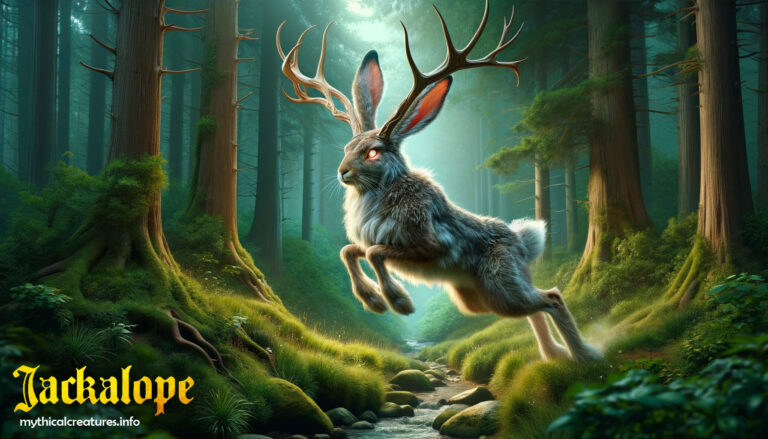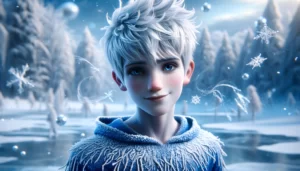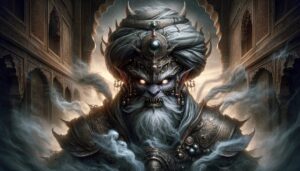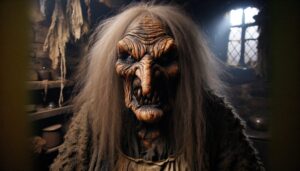Table of Contents
In North American folklore, particularly in the American West, people typically describe the jackalope as a mythical creature. They depict it as a cross between a jackrabbit and an antelope, having the body of a rabbit along with the horns of an antelope. This creature is renowned for its mischievous and elusive nature.
The jackalope often serves as the focal point of tall tales and humorous stories. People claim that it possesses the ability to mimic human voices, leap great distances, and is infamously challenging to capture. Additionally, it has gained popularity as a whimsical symbol in American folklore and occasionally finds use in advertising and as a tourist attraction, especially in specific regions like the southwestern United States.
Appearance

The appearance of a jackalope, as described in North American folklore, combines features of a jackrabbit and an antelope:
Body: The body of a jackalope is typically that of a jackrabbit, which is a type of hare. This means it has the general shape and size of a rabbit, with long ears, a furry body, and powerful hind legs for hopping.
Antlers: The jackalope’s most distinctive feature is its antlers, which people say resemble those of an antelope. They typically depict these antlers as branched and suggest that their size can vary, depending on the specific folklore or portrayal. In some stories, the antlers are described as large and impressive.
Fur: Jackalopes are said to have fur that varies in color, often similar to that of a jackrabbit, which can range from brownish-gray to white.
Eyes: Some versions of the legend attribute glowing red eyes to jackalopes, enhancing their mystique and heightening their otherworldly appearance.
Abilities
In folklore, the jackalope dazzles with its whimsical and fictional abilities. With the skill of a master ventriloquist, it lures unsuspecting travelers by mimicking human voices. Like a bolt of lightning, it dashes away at incredible speed, deftly avoiding pursuit. Then, with supernatural grace, it leaps over chasms and obstacles, vanishing into thin air at will.
Its mischievous intelligence is unmatched, constantly devising cunning tricks to outwit those who dare to catch it. This trickster figure thrives on chaos and plays pranks with an impish glee. One moment, it’s visible; the next, it disappears into the shadows, making the pursuit seem like a futile game.
In a moonlit forest, a group of travelers set out on a daring adventure, determined to capture the enigmatic jackalope. Armed with cunning traps and sharp wits, they ventured deep into the wilderness, their hearts filled with anticipation.
As they trudged through the underbrush, they heard a familiar voice calling for help. It sounded like a fellow traveler in distress, lost and alone. Without hesitation, they followed the voice, convinced that they were closing in on their elusive quarry.
However, little did they know, the jackalope was playing a clever game. Its mimicry lured them deeper into the heart of the forest, far from their original path. With each step, the pursuit became a wild, chaotic dance, orchestrated by the ultimate trickster.
In the world of the jackalope, reality and fiction intertwined, blurring the lines of what was possible. The travelers, ensnared in this whimsical adventure, soon realized that catching the jackalope was not just a quest for a mythical creature; it was a test of their own wits and determination in the face of an otherworldly enigma.
Origin Story

Long ago in the American West, there was a peculiar and reclusive cowboy named Douglas “Jack” O’Lope. He lived in the remote wilderness and was known for his eccentricity and penchant for strange experiments. Jack had a fascination with both rabbits and antelopes, often observing them in the wild.
One fateful day, while Jack was experimenting with taxidermy in his makeshift cabin, a wild jackrabbit hopped into his dwelling. At the same time, a pair of antlers that Jack had collected and intended to use for another project fell onto the floor. Startled by the noise, the rabbit leaped into the air and landed directly on the antlers. In a bizarre twist of fate, the rabbit’s body became impaled on the antlers.
Rather than being horrified, Jack was intrigued by the unusual creature he had inadvertently created. He carefully preserved the rabbit with the antlers still attached, and the legend of the jackalope was born.
Word of this strange creature soon spread throughout the region, and people came from far and wide to see the “Jack O’Lope’s” creation. They began to refer to it as the “jackalope,” combining “Jack” from its creator’s name and “antelope” from the antlers it possessed.
The story of the jackalope’s creation became a part of American folklore, and it is often recounted to explain the existence of this mythical creature.
Other myths
Chapter Title: Tales of the Elusive Jackalope
The jackalope, a beloved figure in American folklore, is surrounded by myths and stories.
Voice Mimicry: Legends describe its ability to mimic human voices, deceiving and disorienting hunters and travelers in the wilderness.
Evasive Behavior: Often elusive, the jackalope defies capture, even by skilled trackers, adding to its mystique.
Horned Rabbits: Stories emphasize their impressive antlers, occasionally leading to epic horn battles between rival jackalopes.
Pranks and Mischief: As mischievous tricksters, jackalopes play pranks, causing accidents or pilfering food, bewildering those they encounter.
Speed and Agility: Myths highlight their incredible speed and agility, rendering them nearly impossible to catch.
Hunting Adventures: Daring individuals embark on quests to capture jackalopes, resulting in humorous or disastrous escapades.
Bounty Tales: In a few legends, a bounty is placed on jackalopes, luring brave souls to pursue these elusive creatures.
The jackalope’s allure lies in its enigmatic nature, a creature both elusive and captivating, weaving tales of deception, agility, and mischief.
Modern culture
The jackalope occasionally makes appearances in modern literature, movies, and pop culture. Here are a few examples:
Literature:
“The Tales of Alvin Maker” series by Orson Scott Card: This fantasy series features a character named Tenskwa-Tawa, a magical jackalope who assists the protagonist.
“The Illustrated Man” by Ray Bradbury: In one of the short stories, “The Day It Rained Forever,” a character encounters a jackalope.
Movies:
“The Ballad of Buster Scruggs” (2018): In one of the anthology film’s segments, titled “The Ballad of Buster Scruggs,” there’s a humorous scene involving a singing cowboy and a stuffed jackalope.
“The Burbs” (1989): This comedy film briefly features a jackalope mounted on a wall as part of the eccentric neighbors’ decor.
Television:
“Parks and Recreation” (TV Series): In Season 2, Episode 18 (“The Possum”), the character Ron Swanson humorously claims to have seen a jackalope.
“Supernatural” (TV Series): In Season 7, Episode 5 (“Shut Up, Dr. Phil”), a stuffed jackalope appears in a pawnshop.
Pop Culture:
Various video games, including “World of Warcraft” and “Fallout: New Vegas,” feature references to or appearances of jackalopes as mythical creatures.
You can also find jackalope-themed merchandise, such as T-shirts, mugs, and novelty items, in many online stores and souvenir shops.
These examples demonstrate how the jackalope continues to be a whimsical and playful element in contemporary literature, film, and popular culture, often used for comedic effect or to add a touch of the fantastical to a story.
Similarities
The European legend of Lepus Cornutus tells of hares sporting antlers, akin to the jackalope’s horned appearance.
The Wolpertinger, a creature in Bavarian folklore, boasts a peculiar blend of animal parts, including wings and antlers.
Islamic tales speak of the Almiraj, a rabbit-like creature distinguished by its single, spiraling horn.
Sweden’s Skvader is a fantastical fusion of hare and wood grouse, with wings adorning its hare-like body.
Some myths recount the Peryton, featuring a deer’s body and bird-like wings and head, resembling the jackalope’s traits.
FAQ
What are the typical characteristics of a jackalope?
A jackalope is typically depicted with the body of a rabbit and the horns of an antelope. Its appearance may vary in size and detail depending on the storyteller.
Does the jackalope exist in reality?
No, the jackalope is purely a product of folklore and mythology. There is no scientific evidence to support the existence of such a creature.
What are some common myths and stories about jackalopes?
Jackalopes are often attributed with whimsical abilities, such as voice mimicry, incredible speed, agility, and the ability to leap great distances. They are also known for their mischievous behavior and pranks in folklore.
Where did the legend of the jackalope originate?
The legend of the jackalope is most strongly associated with American folklore, particularly in the western United States. It likely originated as a humorous and imaginative tale in the early 20th century.
Are there variations of the jackalope legend in different regions?
Yes, the specifics of the jackalope legend can vary from place to place, with different stories and characteristics associated with the creature in various regions.
How is the jackalope used in modern culture?
The jackalope has become a popular and whimsical symbol in American folklore and is sometimes used in advertising and as a tourist attraction, especially in the southwestern United States. It also occasionally appears in literature, film, and pop culture.
Are there any real animals that resemble the jackalope?
While there are no real animals that exactly resemble the jackalope, certain animals, like hares and antelope, may have inspired elements of the creature's fictional appearance.
Can you buy jackalope-themed merchandise?
Yes, jackalope-themed merchandise, including T-shirts, mugs, and novelty items, can often be found in souvenir shops and online stores, particularly in regions where the legend is popular.
Is there any scientific or academic study of the jackalope?
No, the jackalope is not a subject of scientific study, as it is a purely mythical creature created for storytelling and humor in folklore.




